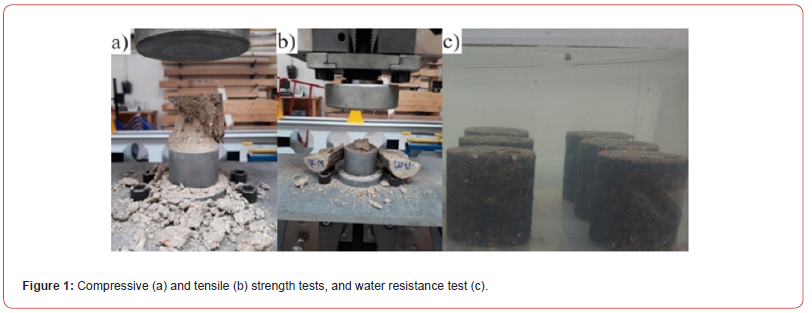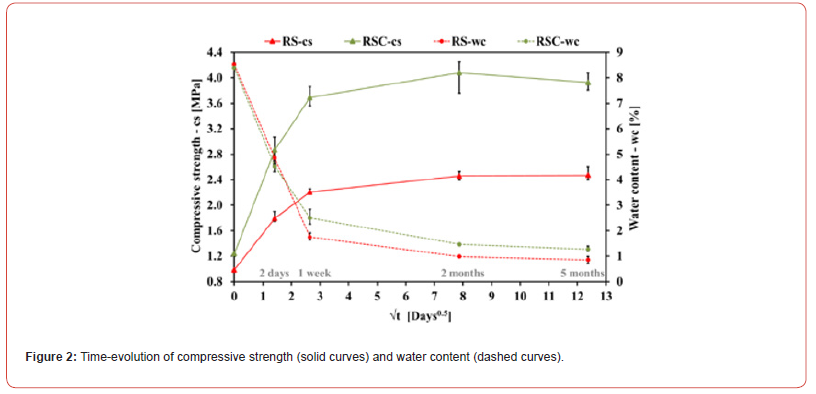 Research Article
Research Article
A Feasibility Study on the Development of Eco- Friendly Compressed Recycled Sand Brick Stabilized with Low Blast-Furnace Slag Cement Content
Luiza Beatriz Gamboa Araújo Morselli1, Akli Younsi2*, Pierre Yves Mahieux2, Maurízio Silveira Quadro1 and Robson Andreazza1
1Federal University of Pelotas, R Gomes Carneiro, Brazil
2La Rochelle University, LaSIE UMR CNRS 7356, France
Akli Younsi, La Rochelle University, LaSIE UMR CNRS 7356, Av M Crépeau, 17042 La Rochelle Cedex 1, France
Received Date:March 12, 2024; Published Date:March 19, 2024
Abstract
This study was conducted to explore the feasibility of developing an eco-friendly brick made from compressed recycled sand, sieved from locally available construction and demolition wastes (CDWs), and stabilized with a low content of blast-furnace slag cement. Ø5×5 cm bricks were produced through axial compression followed by axial extrusion. Their compositions underwent optimization to achieve bricks resistant to crumbling. Two compositions were studied, both with a ratio of water to sand of ~ 9%: a reference brick containing only sand and water, and a brick with a ratio of cement to sand of 2%. Subsequently, some properties and performances of the bricks were characterized. The results revealed that the stabilized brick achieved a compressive strength of up to 4.08 MPa, a diametral tensile strength of up to 0.149 MPa, a thermal conductivity of up to 0.461 W/ (m.K), and a minimum water porosity of 28.4%. Moreover, it demonstrated good water resistance during a 2-hour submersion. This affirms that the stabilized brick meets standard requirements, confirming its feasibility.
Keywords:Recycled sand; Blast-furnace slag cement; Compression; Stabilization; Eco-friendly brick
Introduction
CDWs are increasingly recognized as valuable resources for producing cementitious materials and road paving [1]. Simultaneously, the construction sector shows a growing interest in developing compressed earth bricks [2-4]. Typically, these bricks are stabilized with mineral binders such as Portland cement to enhance their properties and performance [2,4]. In line with environmentally conscious efforts, this study aims to investigate the feasibility of creating an eco-friendly brick. The proposed brick would be manufactured from compressed recycled sand sourced from local CDWs and stabilized with a minimal amount of blastfurnace slag cement. This cement has a lower clinker content compared to Portland cement, resulting in a more favorable environmental impact.
Materials and Methods
The studied cylindrical Ø5×5 cm bricks were crafted by utilizing
a. Recycled sand with a particle size range of 0/6.3 mm,
obtained through sieving dry inert CDWs sourced from a
recycling platform in La Rochelle, France, and
b. CEM III/A 42.5 N cement. This cement, conforming to
EN 197-1, comprises 62 wt% blast-furnace slag and 38 wt%
clinker.
The collected CDWs primarily consist of concrete grains, clay bricks, bituminous grains, and natural aggregates, with smaller quantities of ceramic tiles. Particle size analysis of the recycled sand, conducted in accordance with EN 933-1, revealed a mean diameter d50 of 0.526 mm. Additionally, the recycled sand exhibited an apparent density of 1.54 g/cm³, measured according to EN 1097-3, a real density of 2.39 g/cm³ determined according to EN 1097-6, and a methylene blue value of 0.17 following EN 933- 9. The Ø5×5 cm bricks were produced through axial compression, followed by axial extrusion, in accordance with EN 13286-53. Their compositions, as summarized in Table 1, underwent optimization to achieve a minimum initial compressive strength of 1 MPa, ensuring the production of samples resistant to crumbling. Two compositions were studied, both with a theoretical mass ratio of water to dry recycled sand of approximately 9%: (i) RS, a reference composition containing only recycled sand and water, and (ii) RSC, with a mass ratio of blast-furnace slag cement to dry recycled sand of 2%. After production, the bricks were stored in a room with a temperature of 25 ± 5°C and a relative humidity of 60 ± 5%. Mass monitoring was carried out until near stabilization was reached, which occurred after 5 months.
Table:Compositions of Ø5×5 cm bricks [g].

Compressive strength tests were conducted on three Ø5×5 cm bricks at 0, 2, 7, 62, and 153 days, following EN 13286-41 (Figure 1a). After each brick was crushed, water content was determined in accordance with EN ISO 17892-1. After a quasistabilization of the mass over 5 months of conservation, some properties and performances of the bricks were characterized. First, diametral tensile strength tests were conducted on three Ø5×5 cm bricks, following EN 13286-41 (Figure 1b). Second, water resistance tests were performed on three Ø5×5 cm bricks, with dry bricks submerged under 5 cm of water for 2 hours (Figure 1c). Subsequently, their compressive strength was measured in the dry state, following EN 13286-41. Third, water porosity was measured on three Ø5×5 cm bricks, following NF P18-459. Finally, thermal conductivity was evaluated on nine dry Ø5×5 cm bricks using the hot wire method derived from ASTM D5930-97 and the RILEM A/C 11-3 recommendations.

Results
Time-evolution of compressive strength and water content
Figure 2 illustrates the time-evolution of both the compressive strength and water content in Ø5×5 cm bricks. Over time, there is an increase in compressive strength accompanied by a corresponding decrease in water content. For RS bricks, the strength increase can be primarily attributed to (i) the rise in capillary tensions associated with the drying process [1], leading to the observed reduction in water content, and (ii) the formation of physical bonds between grains due to the slight reactivity of the recycled sand [1]. In the case of RSC bricks, in addition to the aforementioned factors, the ongoing hydration reaction of the cement used plays an important role. This reaction generates hydrates, densifies the microstructure, and consequently enhances the compressive strength. It is noteworthy that, due to the hydration reaction, the incorporation of 2 wt% blast-furnace slag cement results in an enhancement of up to 40% in compressive strength, starting from 2 days, when compared to cementless bricks.

Brick properties and performance at 5 months
Table 2 summarizes the properties and performance of Ø5×5 cm bricks measured at 5 months. Similar to the results for compressive strength, the addition of 2 wt% blast-furnace slag cement enhances both the diametral tensile strength and water resistance of cementless bricks due to the hydration reaction. RSC bricks exhibit diametral tensile strength nearly twice that of RS ones. Furthermore, RSC bricks experience a dry mass loss after 2 hours of water immersion that is 15 times lower than that of RS ones. Regarding compressive strength after 2 hours of immersion, (i) it decreases by nearly one-third for RS bricks, likely due to the disappearance of capillary tensions with water saturation [1], and (ii) increases by more than one-sixth for RSC bricks, probably due to cement rehydration.
Table 2:Some brick properties and performance at 5 months.

The water porosity results underscore the significance of stabilization through cement. Specifically, the RS bricks, which showed relative resistance during a 2-hour water immersion, completely disintegrated after 24 hours of vacuum saturation. This disintegration is likely attributed to the disappearance of both capillary tensions (caused by drying) and physical bonds between grains (formed due to the slight reactivity of recycled sand). In contrast, the RSC bricks perform well due to the hydration of their cement.
The thermal conductivity measurements on dry bricks revealed a slight increase of approximately 7.5% with the addition of cement. The hydration of the cement indeed slightly densifies the microstructure, facilitating heat transfer. Nevertheless, it is important to note that, given the accuracy of the measuring device, the results for RS and RSC remain within the same order of magnitude.
Discussion
The compressive strength, porosity, and thermal conductivity of the RSC brick align with literature values [2-4]. Additionally, in terms of the characterized properties, especially compressive strength, RSC appears to meet the requirements of XP P13-901, which specifically governs earth bricks and blocks for walls and partitions. This classification positions RSC within the BTC20 category and potentially even BTC40. In France, hollow concrete blocks that conform to EN 771-3 play an important role in constructing various masonry walls. Consider, for instance, a 20×20×50 cm block with a compressive strength of 4 MPa, a thermal conductivity of 0.869 W/(m.K), and a Portland cement mass of 1.5 kg. An RSC brick of identical dimensions would have an equivalent Portland cement content of 3.75 wt% [2]. In this investigation, RSC boasts an equivalent compressive strength (up to 4.08 MPa) and better thermal conductivity (up to 0.461 W/(m.K)) than the hollow concrete block. It incorporates only 2 wt% of cement and relies on recycled sand. Furthermore, the cement used has a low clinker content, at only 38 wt%, contributing to a reduced environmental impact.
Conclusion
This study investigated the potential for developing an environmentally friendly brick using compressed recycled sand sourced from CDWs. Stabilized with a low blast-furnace slag cement content, the resulting brick exhibited notable properties, including a compressive strength of up to 4.08 MPa, a diametral tensile strength of up to 0.149 MPa, a thermal conductivity of up to 0.461 W/(m.K), and a minimal water porosity at 28.4%. Additionally, the brick demonstrated good water resistance during a 2-hour submersion. This confirms the compliance of the stabilized brick with standard requirements, emphasizing its feasibility.
Acknowledgments
The authors acknowledge the Brazilian funding institutions CNPq and CAPES, the Federal University of Pelotas, and La Rochelle University for supporting this research. They gratefully thank Rafik Belarbi (LaSIE UMR CNRS 7356, La Rochelle University) for supplying the thermal conductivity meter.
References
- Hou Y (2021) Contribution au développement de la valorisation des déchets inertes du BTP: Étude de la carbonatation des granulats recyclés compactés, La Rochelle University, PHD Thesis, France.
- Ouedraogo KAJ, Aubert JE, Tribout C, Escadeillas G (2020) Is stabilization of earth bricks using low cement or lime contents relevant? Construction and Building Materials 236: 117578.
- Abid R, Kamoun N, Jamoussi F, El Feki H (2022) Fabrication and properties of compressed earth brick from local Tunisian raw materials. Boletín de la Sociedad Española de Cerámica y Vidrio 61: 397–407.
- Brahim M, Ndiaye K, Aggoun S, Maherzi W (2022) Valorization of Dredged Sediments in Manufacturing Compressed Earth Blocks Stabilized by Alkali-Activated Fly Ash Binder. Buildings 12: 419.
-
Luiza Beatriz Gamboa Araújo Morselli, Akli Younsi*, Pierre Yves Mahieux, Maurízio Silveira Quadro and Robson Andreazza. A Feasibility Study on the Development of Eco-Friendly Compressed Recycled Sand Brick Stabilized with Low Blast-Furnace Slag Cement Content. Cur Trends Civil & Struct Eng. 10(5): 2024. CTCSE.MS.ID.000746.
-
Recycled sand; Blast-furnace slag cement; Compression; Stabilization; Eco-friendly brick; Iris Publishers; Iris Publishers Group
-

This work is licensed under a Creative Commons Attribution-NonCommercial 4.0 International License.






